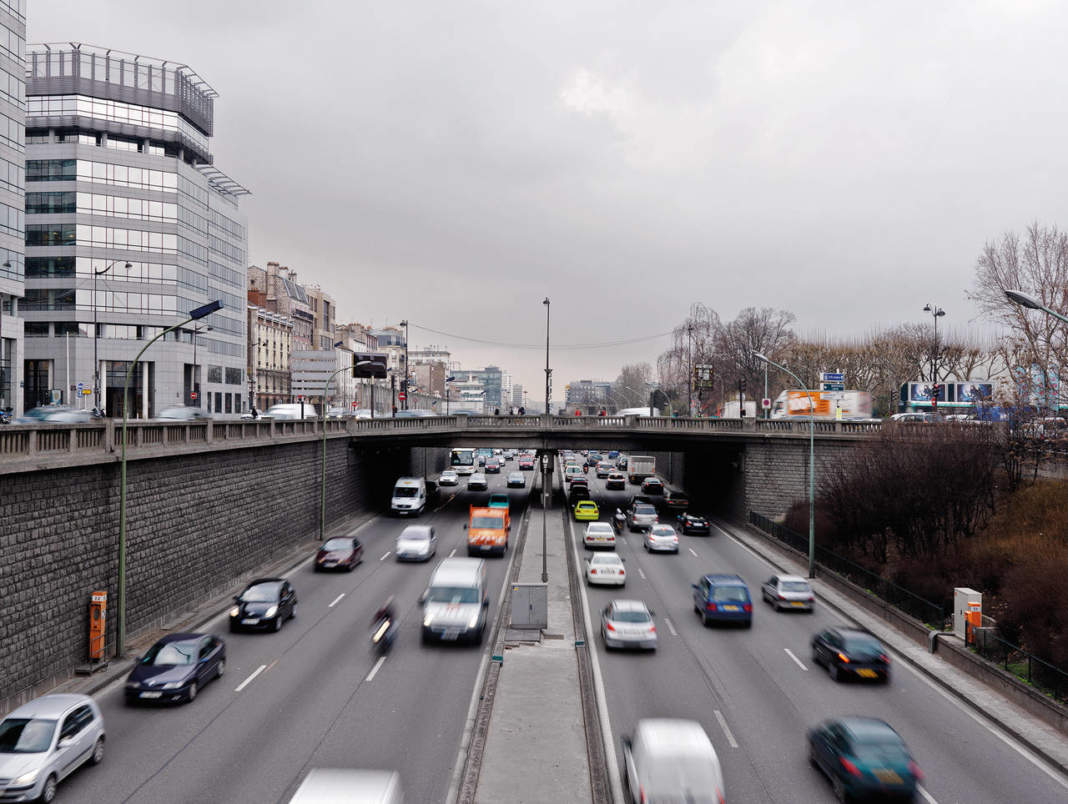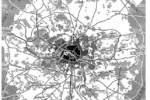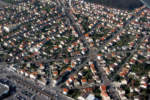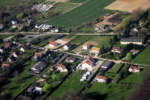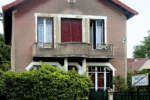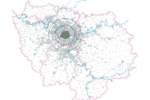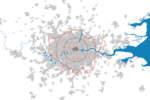The Greater Paris International Consultation
The last transformation of Paris took place in 1860 and was the work of Baron Haussmann, then prefect of the Seine Department. At that time the city covered 100 km² and was surrounded by villages, farming hamlets and some historical cities (Saint-Denis, Saint-Germain, Versailles, Vincennes or Argenteuil) which had been connected to the Capital by rail for some years. In the first half of the 20th century the need to expand the urban agglomerate beyond the area enclosed by the town walls became evident, and this was achieved through a number of projects. The most famous of them is certainly that of urbanist Henri Prost (1934); it was approved in 1939 but the war prevented its implementation. The town plan defined by Paul Delouvrier in 1965 represents the first modern planning document; it features the creation of villes nouvelles, the realization of the RER (Réseau Express Régional) or rapid underground of Paris, as well as the subdivision of the departments of Seine-et-Oise into 7 new departments. However, during this reorganization the borders remained those of Haussmann’s Paris, thus perpetuating the fracture, if not even antagonism, between Paris and its outskirts, areas which have remained unaltered also during the subsequent revisions of the town plan (1976 and 1994). Matters changed with the revision of the town plan for the Ile-de-France Region, a project which has, since 2005, been subject of a public debate on the advisability of reorganizing the metropolis, distinguishing the area of greatest urban density within the region. The idea was then reconsidered in 2007 by the President of the French Republic, who deemed it necessary to hold an international consultation of architects and urbanists for the reorganization of the region of Greater Paris. Since June 2008 ten teams of researchers and experts have been reflecting on the nature of the metropolis of the 21st century and the future of the Parisian agglomerate, while politicians have debated on the necessity of redistributing the responsibility in order to adapt the government to the present territorial reality. The ten teams are led by the following architects: Christian de Portzamparc, Yves Lion, Roland Castro, Antoine Grumbach, Djamel Klouche, Richard Rogers, MVRDV (Winy Maas, Jacob van Rijs, Nathalie de Vries), Finn Geipel, Bernardo Secchi. A final summing-up of the activities should be ready in March and will be followed by a public presentation of the work of the ten teams at the Cité de l’Architecture et du Patrimoine.

The problem of the Parisian metropolis is today a source of concern: governance and scale of the capital, modernization of the urban agglomerate, political strategies are united, against the background of the economic recession, in order to imagine the future of a city which has gone far beyond its administrative limits, with its more than eight million inhabitants. After having briefly expounded the terms of the debate and presented the main players, we will seek to clarify the territorial challenges, returning to the territory and its history.
The delights of governance
The election of Jacques Chirac as mayor of Paris, in 1977, marked the beginning of a new era in the history of the capital. Before that moment, Paris was the only French municipality without a mayor. Capital of a centralized state, seat of government and hotbed of revolution, the governing power feared and distrusted Paris, perceiving a recurrent risk of political opposition: provost of merchants in the Middle Ages (witness Etienne Marcel, 1317-1358, opponent of the future King Charles V and assassinated for this reason), Parliament of Paris in the 17th century or Commune in 1871. Due to this diffidence the royal, imperial or republican power preferred to manage the city directly, placing it under the authority of a Prefect, that is to say an appointed high functionary who was docile and could be revoked at any moment; the most famous such person is Baron Georges Eugène Haussman, Prefect of the Seine Deparment in 1853. Until 1977 it was therefore the Prefect who organized and represented the capital, planning its future and administering its budget, while another functionary, the Police Prefect, was responsible for maintaining order. With Jacques Chirac, former prime minister, a political man of high standing came into power. Preferred by the electors to the candidate backed by the at that time President of the Republic, Valéry Giscard d'Estaing. Chirac, head of the Gaullist party, wanted to transform the city, modernize it, give it prestige and an international dimension which was to benefit his career; in fact, he became President of the Republic in 1995. But the joint actions of the Mayor and the President of the Republic (Mitterand’s great projects) aimed at modernizing Paris, following the example of other great metropolises, did not suffice to give the capital the desired importance. The town planning regulations, which prioritized the protection of the heritage over inventive initiative, hindered innovations. The capital lacked the space for developing ambitious projects as those vaunted by London, Barcelona, Shanghai or Tokyo. It presented its candidacy as host to the Olympic Games (1992 and 2012) without success. The violent and recurrent youth revolts in the suburbs, amply diffused by the media, stained its image. At the same time the decentralization laws of 1982 which transferred powers until then reserved the state to the local districts (cities, departments, regions), especially in the fields of urban and general planning, multiplied the ambitions of the mayors. The great regional capitals, Lille, Lyon, Bordeaux, Marseilles, Nantes or Strasbourg underwent renovation. Mayors and Regional Councils formed alliances to fund projects and together promote the image of the city and region within the context of a globalized economic competition. All kept in mind the example of Barcelona, understanding that town planning and its diffusion in the media represented a formidable winning card. The fact that Paris failed to be chosen as host of the Olympic Games of 2012 revealed the lack of a real understanding between the city and the region, in spite of a shared political orientation and alleged covenants. Within this context three initiatives opened a new page in the history of Paris: the return of Greater Paris. The revision of the Town Plan for Ile de France (SDRIF), resolved on in 2005, marked a turning point in the technocratic planning routines. From the town plan wanted by De Gaulle in 1965 and designed by Paul Delouvrier until the revised versions of 1976 and 1994, the planning was dictated by the State. For the first time, the new town plan was prepared on the initiative of the region, and in other words under the responsibility of elected politicians rather than by the administration. Mireille Ferri, vice president put in charge of the project, launched a widespread public debate on the matter, encouraging contributions and countless meetings.

The issue left the secret rooms of the technicians to be discussed by the civil society. At the same time the Parisian municipality, directed by Bertrand Delanoë, new mayor as of 2001, initiated collaborations with the neighbouring municipalities which resulted in the creation of the Metropolitan Conference, which was to promote joint projects that went beyond the municipal limits. Finally, in the summer of 2007, Nicolas Sarkozy, new President of the Republic, assumed responsibility for the problem, launching an international town planning competition and then appointing a Secretary of State in charge of the Region of the capital. Three political levels are thus mobilized today: the State in the person of the President of the Republic, the Region through its President and Vice Presidents, Paris through the Mayor and its collaborators; we must also add the professional milieus and the public opinion. And hidden agendas, on the part of the different positions, cannot be excluded. Without venturing too far, one may be justified in supposing that the Head of State may be sincerely concerned with the role and place of France in international plays, that he may also be worried about the economic development of the region, but that he wouldn’t mind creating a rift between two collective entities, the city of Paris and the Ile de France region, led by the same party, which might join forces to head an opposition that would be equally head-on and dangerous, as the region is almost entirely in the hands of the socialists. The mayor of Paris, who is not too fond of the President of the Region, may consider the opportunity of acquiring an advantage for his presidential ambitions by confederating from 6 to 9 millions of inhabitants of the central agglomerate, while the leading elected politicians of the urban agglomerate prudently observe and consolidate their own positions. But beyond calculations, the problem of the metropolitan identity and the planning of the territory of the urban agglomerate is today clearly posed and debated. And while it is still too early to know the exact consequences, there is no doubt that the awareness of the issue and the interest it elicits will require a result. Concrete, hard-to-ignore facts already appear: the preservation and enhancement of the farmland and natural areas of a territory which is one of Europe’s richest agricultural regions, something which calls for the densification of the urbanized areas; proof of a considerable effort in favour of public transport and the reinforcement of existing central points; the need for large-scale housing projects and the urgency of wide-scope projects for the peripheries... Elected politicians from all parties are already getting mobilized and acquiring expertise on issues which have for a long time been considered taboos.

Returning to the territory
Greater Paris did not see the light of day thanks to Bertand Delanoë, Mireille Ferri or Nicolas Sarkozy. It has a political history of solidarity, conflicts, projects and dreams which has continued for centuries and which has left its mark on a territory shaped by two millennia of urban life, in the centre of one of the world’s most prosperous regions. In fact, Ile de France is both a large agricultural regions which vaunts record yields in the production of cereals and a first-rate economic centre; its GDP is equivalent to that of the Netherlands, 40% of the middle managers and 60% of the researches in all France operate in this area whose population represents 20% of the national figure. A completely French peculiarity: a strong capital region without a metropolitan governance, in a country which is still centralized, appears as a handicap to everyone, at the same time whetting many appetites. It is not hard to understand the importance of the location of Paris (Lutetia): an easy crossing of the Seine thanks to the Ile de la Cité, a place where many great roads meet, a point which takes every advantage of the geography, avoiding the traps of the twisting river, gliding effortlessly among the hills. But the city’s area of influence has, since its origins, gone far beyond the site of the capital, the current 107 km2 of the municipal territory. In Gallic-Roman times the territory of the Civitas of the Parisii described by Michel Rollin covered more than 1500 km2, reaching beyond Roissy to the north and Arpajon or Corbeil to the south, just short of Meaux to the east, and to the feet of Saint-Germain to the west, as if the stage of the current debate had already, if we except a few details, been defined 1600 years ago. This relationship between city and territory has continued over the centuries. The domination has changed nature; in the belligerent and religious Middle Ages the fortifications of Monthléry and Chevreuse represented the defensive outposts of Paris, which housed about 50,000 inhabitants on the 272 hectares enclosed by the walls built by Louis Philippe, who lived off a much vaster territory, of almost 2,000 km2: farmer villages dedicated to feeding the capital, and above all ecclesiastic properties. Every convent or parish in Paris owned farms and forests in the greater Paris of the period, from which it earned profits and food (Sainte-Geneviève-des-bois depended, for instance, on the abbey of Sainte-Geneviève)...
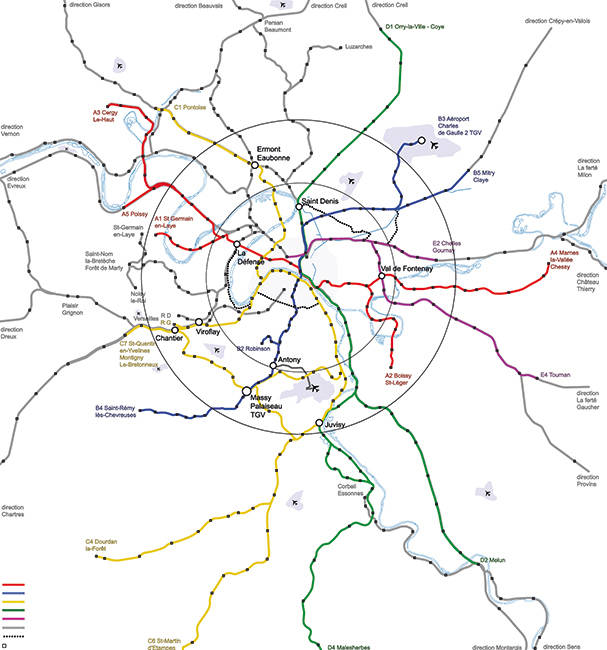
In the 17th century the aristocracy of the court and the gowned nobility of the high administration and Parliament owned much land which represented, at the same time, a source of wealth, hunting grounds and temporary residences. By establishing himself permanently in Versailles with the court and the government, Louis XIV gave a new impulse to the development of the territory. The castles, with their vistas, gardens and parks and the forest-clad hunting grounds with their alleys, streets and roundabouts placed Greater Paris on a different level. On the death of the king, the city only counted 155,000 inhabitants on 1,100 hectares, but Versailles already had more than 25,000 inhabitants and there were many important cities in the vicinity of Paris, as Saint-Denis, Argenteuil, Saint-Germain-en-Laye. In the following century the “Carte des Chasses” (hunting map) drawn by Berthier provided a faithful and detailed image of the territory linked to Paris, which had in 1784 reached a total number of one million inhabitants.

The Revolution of 1789, whose history began in Versailles, gave the Parisian area an institutional form, with the creation in 1792 of the Department of the Seine (503 km2) with Paris as capital; until the mid-20th century it was to form the territory of expansion of the capital, providing space for the budding industry, the manpower necessary for its operations, the reserves, deposits and logistical districts required for the modernization of a great city. Within this territorial scenario, the military city walls of 1842 (Thiers) and then the annexing of the immediate city outskirts in 1860 (Haussman) created a violent rift, isolating the capital from its territory. The conflicts of Greater Paris were born in this moment. Neither the plan designed by Henri Prost (1934), nor the general town plan ideated by Paul Delouvrier (1965) were to prove capable of eliminating the breach between Paris and its periphery. The present-day conditions may, as a whole, give rise to some hope, but the wager of Greater Paris is far from being won.



